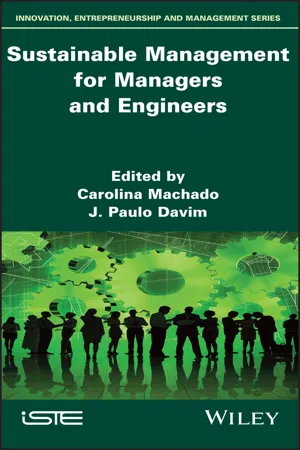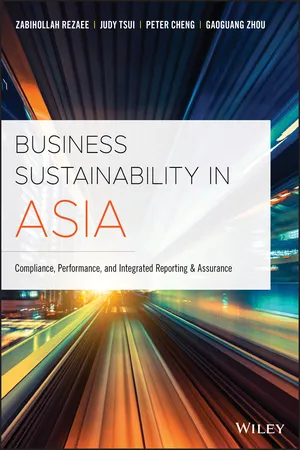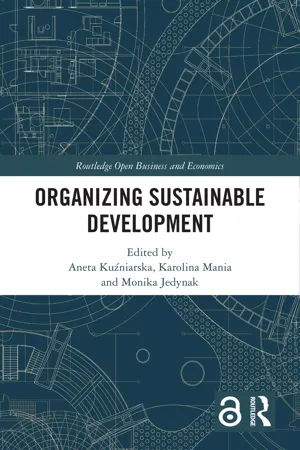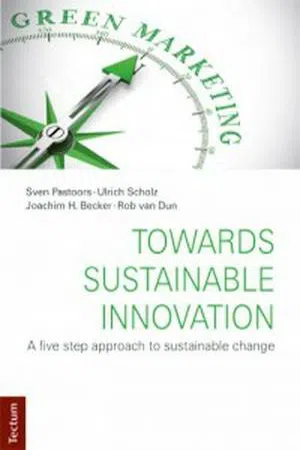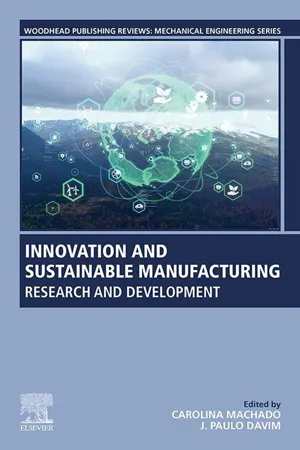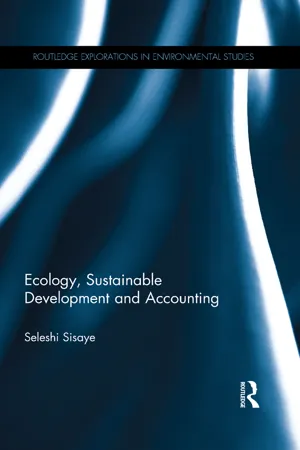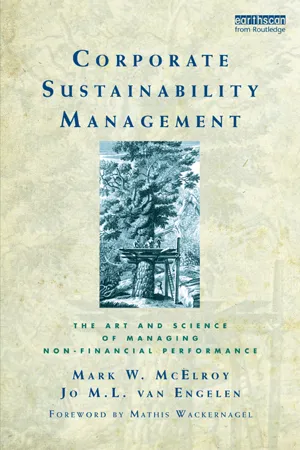Business
Sustainability in Business
Sustainability in business refers to the practice of operating in a way that meets the needs of the present without compromising the ability of future generations to meet their own needs. This involves considering the environmental, social, and economic impacts of business activities and making decisions that contribute to long-term societal and environmental well-being. Embracing sustainability can lead to improved brand reputation, cost savings, and innovation.
Written by Perlego with AI-assistance
Related key terms
11 Key excerpts on "Sustainability in Business"
- Carolina Machado, J. Paulo Davim(Authors)
- 2020(Publication Date)
- Wiley-ISTE(Publisher)
4 Essentials of Sustainability: A Roadmap for BusinessesThis chapter deals with essentials of sustainability from a business management perspective. In this context, sustainability entrepreneurship, sustainable business and sustainability management tools are explained and then sustainability leadership, culture and innovation topics are addressed.4.1. Introduction
Sustainability is a common problem for everyone in the world and unless necessary actions are taken today, there will not be a world in the future where our next generations are able to live. For this reason, all players should take the necessary responsibility for sustainable development. Businesses are also among these players and understanding sustainability from a business management perspective is important. Therefore, in the following sections, sustainability-related issues within an organization will be explained.4.2. Definition of sustainability
Sustainability is a term which is used with different meanings in the literature. These different meanings sometimes result in confusion and misuse of the term. For this reason, it is important to clarify the concept first. Basically, the term “sustainable” means “enduring” or “continuing” and generally it is used to depict things which are “long-lasting”. For example, in strategic management literature, “sustainable competitive advantage” is used to refer to the long-lasting competitiveness of the firm. Similarly, in management literature, the term “sustainable human resources” is generally used for retaining human resources in the long run. A different meaning of sustainable is when it refers to a three-dimensional phenomenon, as in “sustainable development”. These dimensions, namely, environmental, social and economic, together constitute the main factors of sustainability, and when this term is used before a word (such as sustainable business), it means applying the philosophy of sustainable development in this area (here, in business). In this chapter, sustainability will be used with this second meaning.- eBook - ePub
Business Sustainability in Asia
Compliance, Performance, and Integrated Reporting and Assurance
- Zabihollah Rezaee, Judy Tsui, Peter Cheng, Gaoguang Zhou(Authors)
- 2019(Publication Date)
- Wiley(Publisher)
The focus on business sustainability can benefit business organizations in many ways, including higher market and accounting performance, improved business reputation, enhanced product innovation and earnings growth, customer and employee satisfactions and creation of more stakeholder value. Yet, sustainability can be viewed as a box-ticking compliance and risk-mitigation exercise. It is defined in this book by encompassing all the above definitions in creating synergy for business strategies, activities and performance from ethical, environmental, social, compliance, legal, governance and economic dimensions in creating shared value for all stakeholders. A report released by the International Federation of Accountants (IFAC, 2015: 3) indicates that global business organizations are expected to “take responsibility for a broader range of sustainability issues, such as social and environmental aspects that will ultimately affect financial performance and an organization's ability to create value over time.” 7 In summary, business sustainability is defined as a process of focusing on the achievement of all five: economic, governance, social, ethical and environmental (EGSEE) dimensions of sustainability performance in creating shared value for all stakeholders. 4. THEMES OF THIS BOOK Business sustainability has advanced from the branding and greenwashing of focusing on CSR to the strategic imperative of achieving both financial economic sustainability performance (ESP) and non-financial GSEE sustainability performance in the past decade. There are five primary themes in this book, which present a framework for the five dimensions of business sustainability performance (EGSEE) and 10 sustainability principles. 8 These five themes are also applicable in all 12 Asian jurisdictions and their economies - eBook - ePub
Environmental Social Governance
Managing Risk and Expectations
- Karlheinz Spitz, John Trudinger, Matthew Orr(Authors)
- 2022(Publication Date)
- CRC Press(Publisher)
Dobson 1996 ).This confusion notwithstanding, sustainable development has become widely accepted as the fundamental guiding principle for long-term global growth. The focus of sustainable development is the integration of environmental, social, and economic concerns into all aspects of decision-making, allowing business leaders to assess the sustainability of their companies and related activities. While some projects may not meet all sustainability objectives, environmental management standards and project closure have developed such that sustainability is achievable in most situations – companies indeed can do well by doing good. The key here is that we, as business leaders, should demonstrate that the benefits of our industrial activities outweigh the negative impacts.1 Chapter borrows from “Mining & Sustainability: The Three Circles of Sustainable Development” by John Trudinger and Karlheinz Spitz, 2009; Title borrowed from “Yes, Sustainability Can Be a Strategy” by Ioannis Ioannou and George Serafeim, Harvard Business Review, 11 February 2019.Profit, People, and Planet
Three words summarise the traditional approach to business: Profit, Profit, and Profit. In the past, our engineers, and we as leaders, formulated, designed, and executed projects ensuring technical and regulatory compliance but paying little attention to social and environmental impacts and risks. Today’s approach to business has changed; more and more business is about Profit, People, and Planet. Companies must consider their larger footprint. The smartest companies have learned how to do it in a profitable, environmentally and socially responsible way. However, profitability seldom happens by accident. Without proper planning and foresight, navigating environmental legislation and committing to social investments could drain the business dry, abruptly ending the transition toward sustainability. - eBook - ePub
- Gilbert Silvius, Ron Schipper, Julia Planko, Jasper van den Brink(Authors)
- 2017(Publication Date)
- Routledge(Publisher)
However, not only governments worry about sustainable development. Many businesses and consumers also understand that we cannot continue to produce and consume the way we do now. Everyone who has ever tried to go on a diet or start a regular exercise regime knows that to understand something should be done and to act upon it are two different things. The warning signs are getting stronger and people are more informed. Tremendous oil spills, natural disasters, climate change and environment-related health problems are just a few of the more alarming signs that make the public aware that there is a problem. Whereas governmental regulations are essential for a change in status-quo, the driving force of this change can and perhaps should be businesses.2.2 SUSTAINABILITY IN THE BUSINESS CONTEXTThe concept of sustainability is based on balance or harmony between the three dimensions: social equity, environmental protection and economic prosperity. In the business world these three dimensions are often called ‘people, planet, profit’ or PPP. The PPP concept implies that a company should take its decisions with consideration of people – its employees as well as other stakeholders and society – and the planet – that is, the environment – as well as profit. Since the primary goal of most companies is to generate shareholder value, the ‘profit’ dimension is well represented in business strategies and policies. Almost by definition, companies are organized with a strong orientation towards the economic perspective.The environment and the social perspectives, however, are often less embedded in a company’s strategies and practices. Hence, organizations who try to contribute to more sustainable development of our world should focus more on the reduction of the negative environmental and social impacts of its operations while maximizing positive environmental and social impacts.Many of the larger companies of the world, like Unilever, General Electric and Walmart, have already accepted corporate sustainability as an integrated aspect of doing business. Strategies for integration involve appointing corporate sustainability officers, publishing sustainability reports and incorporating sustainability into their corporate communication strategies (Dyllick and Hockerts 2002). Clearly, like all business strategies, a sustainability strategy needs clear objectives and needs to be measured. In 1994, John Elkington coined the term ‘triple bottom line’ (TBL), in his book Cannibals with Forks - eBook - ePub
- Aneta Kuźniarska, Karolina Mania, Monika Jedynak, Aneta Kuźniarska, Karolina Mania, Monika Jedynak(Authors)
- 2023(Publication Date)
- Routledge(Publisher)
Burchell, 2008 ):- Positive impact of enterprises on the environment;
- Ensuring a positive perception of trademark and reputation;
- Implementation of environmental processes that are in compliance with the planned environmental effect;
- Achievement of appropriate financial performance while taking into account elements of sustainable development;
- Execution of multi-dimensional programs relating to economic, environmental and social areas;
- Implementation of efficient and effective strategies of competing based on sustainable business;
- Responding with clarity to the following question: Can a responsible enterprise operate to function better, or can a well-functioning enterprise be more responsible?
- Preparing and testing effective business scenarios;
- Conducting an appropriate division of labour that would ensure growth in the economic sphere, while also raising the ecological awareness of those employed, which may translate to appropriate pro-social behaviour;
- Searching for and eliminating gaps in the area of the sustainable development of the enterprise on the basis of ratio analysis.
In these times of sustainable management, it is worth considering a holistic view of sustainability (that is, the simultaneous consideration of the environmental, social and economic dimensions of sustainability). The elements of the environmental, social and economic dimensions of sustainability have an interdependent nature among themselves. Excessive emphasis on one dimension can have a negative impact on the other two dimensions. Therefore, managers should find intelligent compromises, which is essential if they want to achieve sustainable development. Likewise, it is important to see how these dimensions affect each other (Renukappa, Egbu, 2012). Today’s challenge for decision-makers is to achieve a certain level of comfort in terms of respecting social responsibility, economic viability and environmental sustainability, while protecting the legacy for future generations. Research relating to sustainability can be broadly divided into research related to financial performance or enterprise value and research related to revenue management (Lee, 2011 ). On this basis, H. Y. Ma and J. Y. Yoo conducted an analysis of research in these areas and indicated the following (Ma, Yoo, 2022 - Joachim H. Becker, Sven Pastoors, Ulrich Scholz(Authors)
- 2017(Publication Date)
- Tectum(Publisher)
4 describes the ability of a community, organisation or a company to operate in such a way that they also have the capacity to endure into the future. This does not only apply to every individual and every company, but also for humanity as a whole. In the long-term, the current global community cannot live at the expense of future generations. This also includes individual communities not being allowed to consume in such a way that they burden people in other regions of the world.Even though the first calls for the sustainable use of the natural resources were already made in antiquity, the efficient use of natural resources did not play a role for a long time (Rogall 2012, p. 29-31). The term “sustainability” itself derives initially from the forestry sector in the 18th century.5The discussion about sustainable development originates from the global economic crisis of the 1970s. This crisis made it clear that we are endangering our own livelihood through the exploitation of natural resources. Today, sustainability is an economic concept. Economic, ecological and social developments must not be separated from one another or played off against each other: no permanent economic and social progress without an intact environment – no intact environment without economic and social well-being.Sustainability is a cross-sectional task, because it affects all the areas of our lives. Its implementation is a global challenge. Due to globalisation, the social, economic and ecological consequences can be felt worldwide. Environmental and development problems cannot be solved by one country alone; hence they must be solved together in close collaboration. From this, the three dimensions of sustainability can be deduced:- eBook - ePub
Sustainability
Duty or Opportunity for Business?
- Michael Norton(Author)
- 2012(Publication Date)
- Routledge(Publisher)
1 This requires answers to questions concerning the three pillars of sustainable development:• Environmental – what is your impact on pollution, climate change, sustainable use of natural resources (e.g. water, fisheries and forests), and how do you manage new or hazardous technologies?• Social – what is your responsibility for issues such as respect for human rights in the developing world, equitable pay, the growing gap in wealth between North and South? How do you respond to the demand for ethical practices in business?• Economic – how can your business act responsibly and yet contribute to economic growth and stability: for instance, by providing safe jobs, creating wealth for shareholders or providing quality products and services?Sustainable businesses should help consumer needs to be met in a sustainable way. As we saw in Chapter 2 , consumption in industrialized societies is several multiples of a level which is sustainable (see also WWF, 2007). A first priority is thus helping consumption become more sustainable; in other words, meeting the same customer needs/markets while reducing energy and material inputs and in-use consumption. To achieve this, there are a number of general strategies:Figure 3.1 Virtuous circle of environmentally friendly businesses and consumers (source: MOEJ, 2008).• dematerialization (e.g. less material content); • re-use and recycle (i.e. use the resource more than once); • raise efficiency (e.g. low energy living, high efficiency appliances, low fuel consumption cars);• encourage better indicators of consumption to discourage unproductive or harmful consumption (e.g. GPI instead of GNP; well-being rather than material goods consumption; internalization of environmental costs (such as through carbon tax or price)); - eBook - ePub
- Gunnar Rimmel, Gunnar Rimmel(Authors)
- 2020(Publication Date)
- Routledge(Publisher)
Partnerships are a further trend described by Elkington. Due to tightening markets and opportunities, Elkington claims that organizations increasingly are forced to engage in partnerships they earlier would not have found acceptable or even doable. The new relations enable organizations to seek business advantages that might not have been interesting before.Time has an aspect in this because financial markets and digitalization create a strong focus on short-term developments, while business survival builds at least as much on long-term planning as on short-term results.Finally, corporate governance and increased focus on corporate governance are described as a societal trend, with important consequences for holistic management. Sustainability and sustainable development cannot be achieved by exclusively focusing on products and processes. The organizational boards have to become aware of the new challenges and need to build the vision of TBL into the “corporate DNA” from the outset. In the introduction to their book The Triple Bottom Line , Savitz and Weber (2014, p. 2) summarize the idea as follows:Sustainable organizations and societies generate and live off interest rather than depleting their capital. Capital, in this context, includes natural resources, such as water, air, sources of energy, and foodstuffs. It also includes human and social assets – from worker commitment to community support – as well as economic resources, such as license to operate, a receptive marketplace, and legal and economic infrastructure. A company can spend down its capital for a while, but generally not for long. A firm that honors the principles of sustainability, by contrast, is built to last.Savitz and Weber (2014) claim that businesses that think and act sustainable will be able to survive in the long run, whereas unsustainable businesses will not because they will lose resources and support. Instead of considering social and ecological impacts as cost, TBL enables decision-makers to see - eBook - ePub
Innovation and Sustainable Manufacturing
Research and Development
- Carolina Machado, J. Paulo Davim(Authors)
- 2022(Publication Date)
- Woodhead Publishing(Publisher)
Loknath and Azeem (2017) , various researchers who have been dedicated to the domain of green management have traditionally categorized the concept of CSR from a kaleidoscope of assumptions, which can be better understood in light of the classification of organizations based on their strategic options. Therefore we can, as a starting point, discuss the difficulty of a consensual initial definition for this core concept of CSR in terms of the organizational environmental and social footprint. This stems from the fact that, as has been pointed out in the literature on this topic, environmental management and corporate sustainability have traditionally been investigated as concepts applied in close conjunction with (or even as a substitute for) green management. The literature clearly points out the theoretical, conceptual, and managerial overlap, that is, fusion and confusion.Nonetheless, in the literature it is seen that both concepts seem to entail a wider and more significant scope It can be arguable that they more accurately and fully embrace the idea of green management when compared to the fragmented and initial description of corporate environmentalism offered by Costello (2008) .Indeed, the nucleus of the environmental management theoretical construct focuses on management systems that have been designed, implemented, and developed to achieve continuous improvement to act as an effective approach for proactively dealing with environmental issues (Kautto, 2006 ; Kivimaa and Kautto, 2010 ). Hence they also entail an economic conceptual vector as it crosses with the competitiveness and sustainability of the business value chain that the organization presents. Therefore it affects organizational performance and can also be defined in terms of economic profit (Dresner, 2012 ; Florida, Atlas, & Cline, 2001 ; Goodland & Daly, 1996 ; Hervani, Helms, & Sarkis, 2005 ; King & Lenox, 2001 ; Lefebvre, Lefebvre, & Talbot, 2003 ; Puopolo, Teti, & Milani, 2015 ).From this comprehensive viewpoint, the concept of corporate sustainability, which requires continuous improvements in the organizational structure, strategy, policies, processes, and tools to achieve its challenging objectives, may evolve into the concept of CSR as a core value, goal, and action so that the organization thrives by achieving those aims. Furthering this idea and according to Stead and Stead (2000) , transforming sustainability can be seen as an accomplishment instead of a mere goal. This implies that the contemporary economy must urgently, drastically, and fundamentally shift from a focus exclusively on economic growth to involve active steps to design and implement a steady-state economy that allows the survival and good quality of life of the present generations without risking the survival potential and well-being of the future ones (Hawken, 1993 ). This view results in the conceptual umbrellas of green management and circular economy (Fernandes & Machado, 2020a , 2020b ). In other words, such a resource management approach can make it possible that the rates of pollution emissions do not exceed the assimilatory capacity of the earth and that the levels of consumption do not surpass the levels of regeneration so that the rates of nonrenewable resources do not exceed the levels at which sustainable substitutes can be found, developed, and used (Azzone, Noci, Manzini, Welford, & Young, 1996 ; Crane, McWilliams, Matten, Moon, & Siegel, 2008 ; Daly, 1991 ; Foote, Gaffney, & Evans, 2010 ; Harris & Crane, 2002 ; Johnson, 1998 ; Lee & Ball, 2006 ; Netherwood, 1996 ; Orlitzky, Siegel, & Waldman, 2011 ; Taylor, Barker, & Simpson, 2003 - eBook - ePub
- Seleshi Sisaye(Author)
- 2015(Publication Date)
- Routledge(Publisher)
A study by White (2005) affirmed that 81 percent of senior executives at large U.S.-based businesses contended that sustainability practices are very important to their company’s strategic mission. Management indicated that social and environmental responsibilities have influenced their financial performance. White suggested that the continuous scrutiny of corporate practices by consumers, employees, investors and local communities, and government’s oversight of pollution and wastes from the mismanagement of resources, have increased corporations’ compliance with improved environmental resource management (pp36–43). Although the number of U.S. companies that reported sustainability practices was limited in the early 1990s, it increased by the mid-2000s and accounted for over two-thirds of the Fortune 500 companies (White, 2005). By late 2000, according to Dilling (2009 : 22), “about 70% of the studies reviewed showed a positive and statistically relevant relationship between CSR and financial performance.” As the number of corporations who voluntarily disclose social and environmental reports increases, the need for better disclosure on the effective utilization and management of environmental resources has become important in corporate sustainability reports (Sisaye et al., 2004). These reports most often contain economic, environmental and social performance data. They provide information on management’s commitment to responsibly manage environmental resources and future social and environmental strategies. Organizations can use CSR to document their adherence by publicizing the report on the declining or decreasing amounts of fines paid out to implement or continue their sustainable practices. Compliance and the reporting of CSR are expected to improve the financial performance of a company in the long term - eBook - ePub
Corporate Sustainability Management
The Art and Science of Managing Non-Financial Performance
- Mark W. McElroy, J.M.L. van Engelen(Authors)
- 2012(Publication Date)
- Routledge(Publisher)
For all intents and purposes, then, the capital-based, TBL orientation to sustainability (i.e., the dominant school of thought in the field) has never really been fully operationalized, and is practically begging for guidance on how to finish the job by including context in practice. Indeed, what the field of CSM desperately needs right now is a body of context-based TBL theory and practice, which of course is what we claim to be offering in this book.In our embrace of the TBL model as an organizing principle for sustainability, we actually depart from Elkington and many others who hold to it in two important ways: 1. We do not subscribe to the view that the economic bottom line is synonymous with the financial bottom line. As Jennings put it (Jennings, 2004, p. 157):So, while the economic component of the triple bottom line is often assumed to be synonymous with financial performance, in fact, there are significant differences between the two. In its simplest form, finance is about the provision of money when and where required for consumption or for investment in commerce. As such, it concerns the market valuation of transactions that pass through a company’s books. Economics, on the other hand, is the means by which society uses human and natural resources in the pursuit of human welfare. As a result, economics extends beyond the boundaries of a single organization and is inextricably linked to both the environmental and social elements of sustainable development.What this means, then, is that there are actually four major bottom lines to contend with, not three. It is not people–planet–profit , as the now common TBL refrain would have us believe. This is decidedly misleading and leaves out altogether the important economic impacts an organization can have (positive and negative) in society at large, in ways that have nothing to do with their own financial bottom lines. We will have more to say about the practice implications of this view in Chapter 2 .2. We do not subscribe to a strict TBL interpretation in the sense that there are only three non-financial or sustainability bottom lines: social, environmental and economic. Rather, we take the position that there are many more such bottom lines, each of which, however, can indeed be categorized in one or more of the three major groupings (i.e., bottom lines can be composed of sub-bottom lines). An organization’s social bottom line performance, for example, might consist of impacts on employee well-being, community well-being and customer well-being in ways that involve impacts on different forms of capital. Since dissimilar capitals are not interchangeable or substitutable for one another, one cannot simply add them up together in order to arrive at a blended sum (further discussed in Chapter 3
Index pages curate the most relevant extracts from our library of academic textbooks. They’ve been created using an in-house natural language model (NLM), each adding context and meaning to key research topics.
